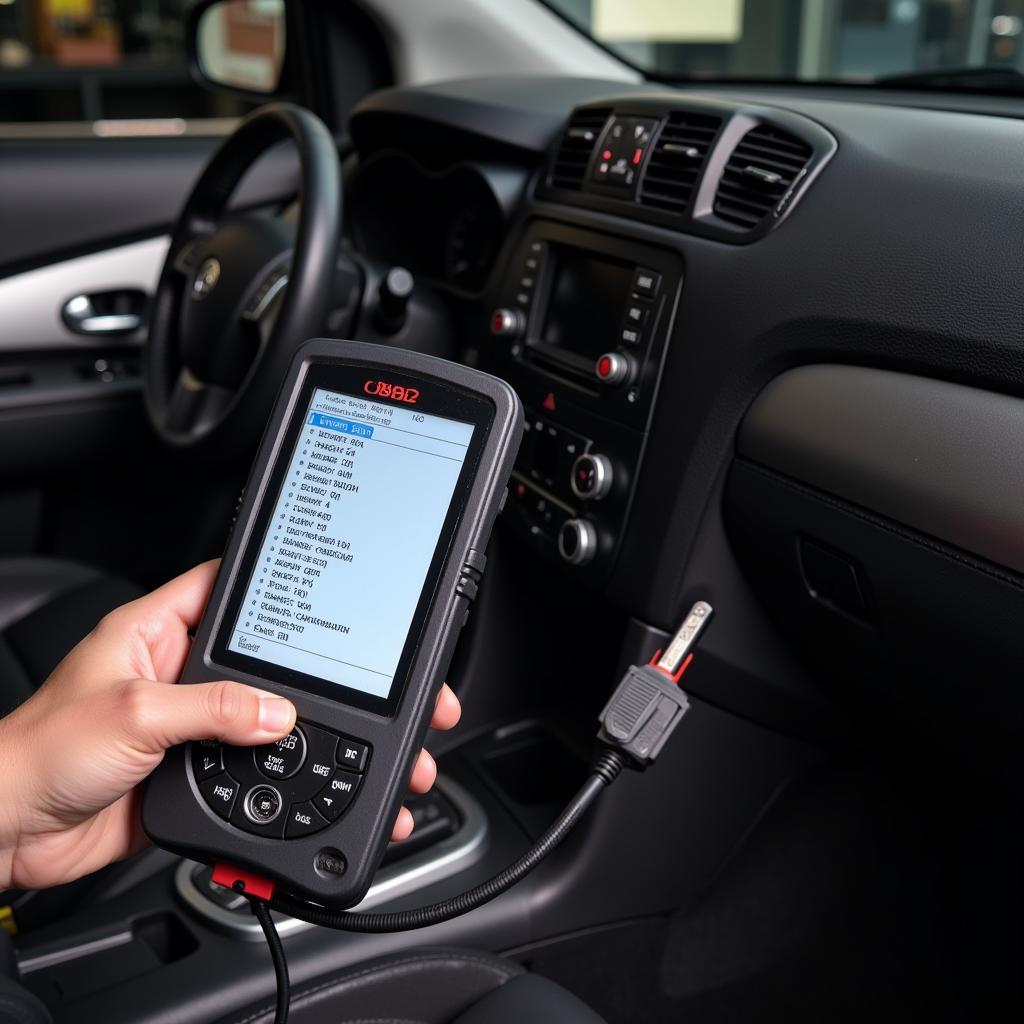Car diagnostic trouble codes can seem like cryptic messages from your car’s computer, but they are actually a valuable tool for understanding and fixing automotive issues. These codes, often referred to as DTCs, are part of your vehicle’s onboard diagnostic system (OBD-II). When the system detects a problem, it generates a specific code that corresponds to the issue.
 OBD2 Scanner Displaying Trouble Codes
OBD2 Scanner Displaying Trouble Codes
What are Car Diagnostic Trouble Codes?
Essentially, these codes act as a starting point for diagnosing problems with your car. They can point to a wide range of issues, from minor sensor malfunctions to more serious engine or transmission problems. Each code consists of a five-digit alphanumeric sequence.
For example, a common code like “P0420” indicates a potential problem with the catalytic converter system.
How are Diagnostic Trouble Codes Read?
To access these codes, you need an OBD-II scanner, a handheld device that connects to your car’s OBD-II port, typically located under the dashboard on the driver’s side. Once connected, the scanner retrieves the stored codes from the vehicle’s computer.
While the scanner provides the codes, understanding their meaning often requires consulting a reliable source like DiagFixPro. Our website offers comprehensive information about various car diagnostic trouble codes, helping you decipher the messages your car is sending.
Why are Diagnostic Trouble Codes Important?
Car diagnostic trouble codes play a crucial role in modern car maintenance and repair for several reasons:
- Early Detection: DTCs often appear before noticeable symptoms arise, allowing you to address potential problems early on and potentially prevent more serious damage.
- Accurate Diagnosis: Codes provide specific insights into the affected systems, making the diagnostic process more efficient and reducing the likelihood of unnecessary repairs.
- Cost Savings: By identifying the root cause of a problem, DTCs help avoid replacing parts unnecessarily, saving you money on repairs.
diagnostic trouble codes for cars
Common Car Diagnostic Trouble Codes
While countless DTCs exist, some appear more frequently than others. Here are a few examples:
- P0420: Indicates a potential problem with the catalytic converter system, often related to emissions.
- P0300: Signals a random or multiple cylinder misfire, which can lead to engine performance issues.
- P0171: Suggests a lean air-fuel mixture, often caused by a vacuum leak or a problem with the oxygen sensor.
What to Do When You Encounter a Diagnostic Trouble Code
- Don’t Panic: Seeing a DTC doesn’t necessarily mean a catastrophic failure.
- Record the Codes: Write down all the codes displayed on your OBD-II scanner.
- Research: Use a trusted source like DiagFixPro to research the codes and understand their potential causes.
- Consult a Professional: If you’re unsure about the diagnosis or repair, seek assistance from a qualified mechanic.
DiagFixPro: Your Trusted Source for Car Diagnostic Information
“Understanding car diagnostic trouble codes empowers car owners to take control of their vehicle’s health,” says John Miller, Senior Automotive Diagnostic Technician at DiagFixPro. “Our platform provides the knowledge and resources needed to make informed decisions about car maintenance and repairs.”
DiagFixPro offers a comprehensive database of car diagnostic trouble codes, along with detailed explanations, possible causes, and common symptoms. We aim to demystify the world of car diagnostics, making it accessible to everyone.
Diagnostic Trouble Code FAQs
Q: Can I drive my car with a diagnostic trouble code?
A: It depends on the code. Some codes indicate minor issues that might not require immediate attention, while others signal serious problems that necessitate stopping the vehicle immediately.
Q: Will disconnecting the battery reset the codes?
A: Disconnecting the battery can temporarily clear the codes, but they will reappear if the underlying problem persists.
Q: Do I need a professional-grade OBD-II scanner?
A: Basic scanners are sufficient for reading and clearing codes. However, advanced scanners offer more features like live data streaming, which can be helpful for experienced users or professionals.
Conclusion
Car diagnostic trouble codes are essential for maintaining and repairing modern vehicles. By understanding these codes and utilizing resources like DiagFixPro, car owners can proactively address issues, save money, and ensure their vehicles run smoothly. Remember, knowledge is power when it comes to car diagnostics!
If you need help interpreting car diagnostic trouble codes or require expert assistance, reach out to our team via WhatsApp at +1(641)206-8880 or email us at [email protected]. Our dedicated customer support team is available 24/7 to assist you.
